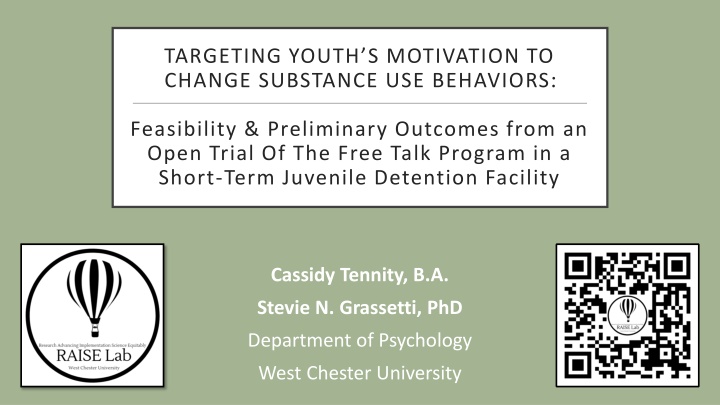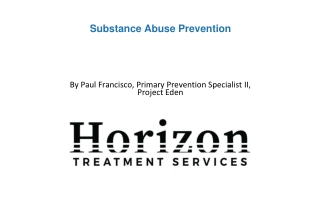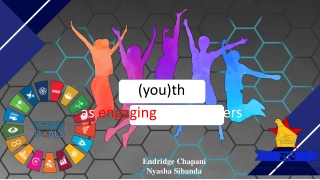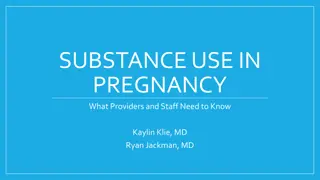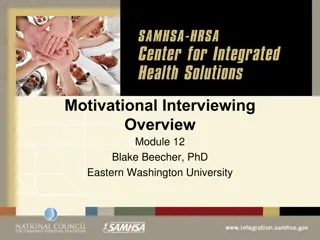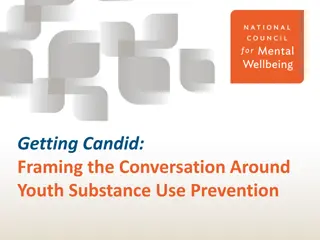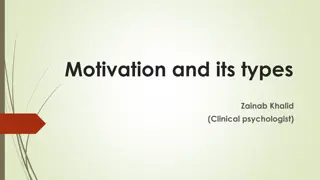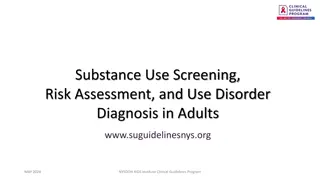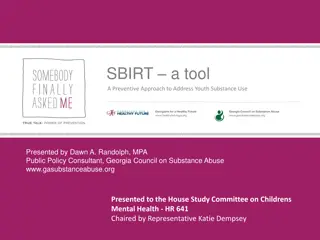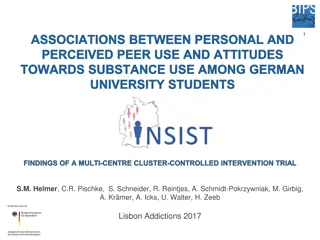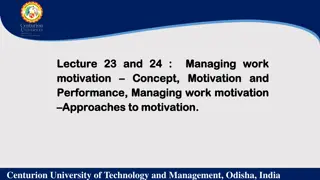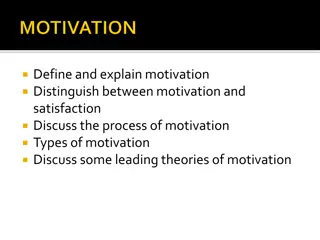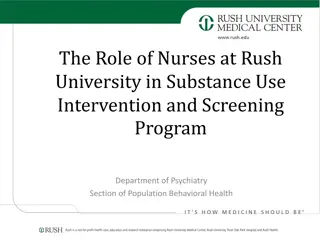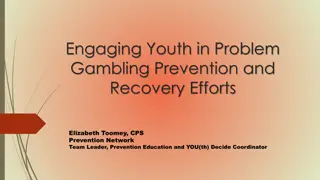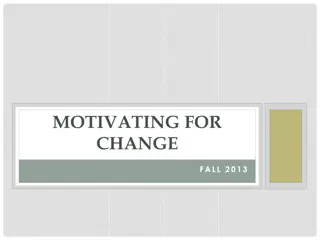TARGETING YOUTH’S MOTIVATION TO CHANGE SUBSTANCE USE BEHAVIORS
Adolescent substance use in juvenile detention facilities poses a significant risk. Motivational interviewing interventions like the Free Talk program show promise in reducing substance use behaviors among youth. This study explores the feasibility and initial results of implementing the Free Talk program in a short-term juvenile detention facility to address substance use disorders and motivate behavior change. Youths' motivation to change substance use behaviors is crucial for long-term positive outcomes and reducing involvement in the justice system.
Download Presentation

Please find below an Image/Link to download the presentation.
The content on the website is provided AS IS for your information and personal use only. It may not be sold, licensed, or shared on other websites without obtaining consent from the author.If you encounter any issues during the download, it is possible that the publisher has removed the file from their server.
You are allowed to download the files provided on this website for personal or commercial use, subject to the condition that they are used lawfully. All files are the property of their respective owners.
The content on the website is provided AS IS for your information and personal use only. It may not be sold, licensed, or shared on other websites without obtaining consent from the author.
E N D
Presentation Transcript
TARGETING YOUTHS MOTIVATION TO CHANGE SUBSTANCE USE BEHAVIORS: Feasibility & Preliminary Outcomes from an Open Trial Of The Free Talk Program in a Short-Term Juvenile Detention Facility Cassidy Tennity, B.A. Stevie N. Grassetti, PhD Department of Psychology West Chester University
Adolescent substance use contributes to an increased risk for a variety of negative outcomes, including delinquency and justice system involvement (Put, Creemers & Hoeve, 2014) The high prevalence of substance use disorders (SUDs) within the juvenile justice system has been consistently demonstrated in research INTRODUCTION & BACKGROUND Half of incarcerated boys and almost half of incarcerated girls met the diagnostic criteria for a SUD (Teplin, Abram, McClelland, Dulcan, & Mericle, 2002) 81.4% of incarcerated youth met the diagnostic criteria for a SUD and for many of these youth, substance use persists into adulthood (Welty et al., 2002) 2
INTRODUCTION & BACKGROUND One one hand, involvement with the juvenile justice- system may create a risk for continued problems with SUDs On the other hand, it is also possible that involvement with the juvenile justice system facilitates an opportunity for underserved youth to access treatment Intervention science has established several interventions to prevent substance use problems in general populations of adolescents, including motivational interviewing. 3
INTRODUCTION & BACKGROUND Motivational interviewing (MI) is a collaborative, goal-oriented conversation style for building a person s motivation and commitment to behavior change (Miller & Rolnick, 2012) May be particularly helpful for juvenile-justice involved youth who may be less likely to respond to more directive approaches (Clair-Michaud et al., 2016) Studies of MI to reduce adolescent substance use have yielded promising results (Jensen et al., 2011) 4
INTRODUCTION & BACKGROUND Free Talk (FT) is a six-session manualized group intervention that aims to increase motivation for substance use cessation (D Amico, Chan Osilla, & Hunter, 2010) Developed for at-risk adolescents participating in a diversion program with a first-time drug charge Uses a motivational interviewing approach Preliminary evaluation of FT revealed reduced substance use at 3 months (D Amico et al., 2012) 5
The current open-trial implementation study aimed to: 1. Evaluate the feasibility of FT within a short-term juvenile detention facility as part of universal health curriculum. 2. Determine whether incarcerated youth participating in FT within the juvenile detention center reported expected changes in motivation to change substance use OBJECTIVES & HYPOTHESES We hypothesize that the youth participating in FT would report a significant increase in motivation to change substance use 6
METHODS N=49 youth aged 12-18 (M age=15.31, SD=1.56) who were detained in a short-term juvenile detention center Primarily African American and male-identifying Racial & Ethnic Identity Gender 4% 12% 16% 84% 84% African American Caucasian Latinx Male Female 7
MEASURES Construct Motivation to Change Substance Use Measures Contemplation Ladder (Biener & Abrams, 1991; Slavet et al.. 2006) URICA (DiClemente, Schlundt, & Gemmel, 2004) Items 1-item self-report visual analog measure 24 items on a 5-point Likert scale from strongly disagree to strongly agree Example Item: I have a problem and I really think I should work on it. Administered Pre- & Post-intervention Pre- & Post-intervention 8
H1: The youth participating in FT would report a significant increase in motivation to change substance use Paired samples t tests revealed: There was no significant difference between pre- treatment (M=8.10, SD=2.86) and post-treatment (M=8.19, SD=2.96) motivation to change substance use as measured by the Modified Contemplation Ladder scores, t(20)=-0.28, p=.785, d=0.33. RESULTS & DISCUSSION There was a significant decrease between pre-treatment (M=6.71, SD=2.74) and post-treatment (M=5.74, SD=2.95) motivation to change substance use as measured by the URICA, t(23)=3.23, p=.004, d=0.35 H1: Contrary to our hypothesis, the youth participating in FT did not report a significant increase in motivation to change substance use 9
DISCUSSION Group treatment can be contraindicated Networking with peers who display deviant and delinquent behavior can influence the socialization of youth and contribute to iatrogenic treatment effects (Dishion, 1994) The results from the current study provide no evidence to suggest that FT is a helpful program when implemented as a universal program It may be that group treatment as a universal program such as FT negatively impacted substance use outcomes Due to the high-risk population and setting, it s possible that deviancy training occurs during the intervention, and when youth learn of other youth whose substance use is worse, they may view their own use as less problematic 10
Barriers to alliance Support for implementation of the intervention varied within the detention center absence of familiar staff members to co-lead groups led to a barrier of rapport building between youth and the therapist FEASIBILITY Planning for future implementations should ensure that a trusted staff member is trained in delivering the intervention and available to lead groups 11
FEASIBILITY Scheduling Barriers Groups took place during visitation and many youth were absent for varying amounts of time during sessions The schedule at the facility changed daily and detention center staff were not able to share the schedule prior to the day of the session Planning for future implementations should ensure that a comprehensive schedule and protocol for sessions should be developed and shared between the clinical/research team and detention center staff prior to implementation 12
Intervention Barriers Although FT requires several clinical materials for games and activities during sessions, the treatment manual does not include these materials FT focuses on discussing the use of a variety of different substances, some of which youth did not endorse using. FEASIBILITY Planning for future implementations should tailor discussions and handouts to relevant substances. Treatment developers could consider creating printable templates for materials or including instructions for clinical materials in the manual. 13
Limitation: No comparison group Future Direction: Randomized controlled design Limitation: Reliance on self-report data while incarcerated Future Direction: Collect parent/guardian report data, long-term follow up after release LIMITATIONS& FUTURE DIRECTIONS Limitation: Did not measure session fidelity Future Direction: Measure fidelity of sessions Limitation: Attendance Future Direction: Create plan for makeup sessions and abbreviated sessions prior to intervention 14
REFERENCES Biener, L., & Abrams, D. B. (1991). The Contemplation Ladder: Validation of a measure of readiness to consider smoking cessation. Health Psychology, 10(5), 360-365. Clair-Michaud, M., Martin, R. A., Stein, L.A.R., Bassett, S., Lebeau, R., & Golembeske, C. (2016). The Impact of Motivational Interviewing on Delinquent Behaviors in Incarcerated Adolescents. Journal of Substance Abuse Treatment,65, 13 19. D Amico, E. J., Osilla, K. C., & Hunter, S. B. (2010). Developing a Group Motivational Interviewing Intervention for First-Time Adolescent Offenders At-Risk for an Alcohol or Drug Use Disorder. Alcoholism Treatment Quarterly, 28(4), 417 436. D Amico, E. J., Hunter, S. B., Miles, J. N., Ewing, B. A., & Osilla, K. C. (2013). A randomized controlled trial of a group motivational interviewing intervention for adolescents with a first time alcohol or drug offense. Journal of Substance Abuse Treatment,45(5), 400 408. Diclemente, C. C., Schlundt, D., & Gemmell, L. (2004). Readiness and Stages of Change in Addiction Treatment. American Journal on Addictions, 13(2), 103 119 Dishion, T. J., Duncan, T. E., Eddy, J. M., Fagot, B. I., & Fetrow, R. (1994). The world of parents and peers: coercive exchanges and childrens social adaptation. Social Development, 3(3), 255 268. Grisso, T., Barnum, R., Fletcher, K. E., Cauffman, E., & Peuschold, D. (2001). Massachusetts Youth Screening Instrument for Mental Health Needs of Juvenile Justice Youths. Journal of the American Academy of Child & Adolescent Psychiatry, 40(5), 541 548. Jensen, C. D., Cushing, C. C., Aylward, B. S., Craig, J. T., Sorell, D. M., & Steele, R. G. (2011). Effectiveness of motivational interviewing interventions for adolescent substance use behavior change: A meta-analytic review. Journal of Consulting and Clinical Psychology, 79(4), 433 440. Miller, W. R., & Rollnick, S. (2012).Motivational Interviewing: Helping People Change. New York: Guilford Publ. Put, C. E. V. D., Creemers, H. E., & Hoeve, M. (2014). Differences between juvenile offenders with and without substance use problems in the prevalence and impact of risk and protective factors for criminal recidivism. Drug and Alcohol Dependence,134, 267 274. Slavet, J. D., Stein, L. A. R., Colby, S. M., Barnett, N. P., Monti, P. M., Golembeske, C., & Lebeau-Craven, R. (2006). The marijuana ladder: Measuring motivation to change marijuana use in incarcerated adolescents. Drug and Alcohol Dependence, 83(1), 42-48. Substance Abuse and Mental Health Services Administration. (2017). Key substance use and mental health indicators in the United States: Results from the 2016 National Survey on Drug Use and Health (HHS Publication No. SMA 17-5044, NSDUH Series H-52). Rockville, MD: Center for Behavioral Health Statistics and Quality, Substance Abuse and Mental Health Services Administration. Retrieved from https://www. samhsa.gov/data/ Teplin, L. A., Abram, K. M., Mcclelland, G. M., Dulcan, M. K., & Mericle, A. A. (2002). Psychiatric Disorders in Youth in Juvenile Detention. Archives of General Psychiatry, 59(12), 1133. 15 Welty, L. J., Hershfield, J. A., Abram, K. M., Han, H., Byck, G. R., & Teplin, L. A. (2017). Trajectories of Substance Use Disorder in Youth After Detention: A 12- Year Longitudinal Study. Journal of the American Academy of Child & Adolescent Psychiatry, 56(2), 140 148.
